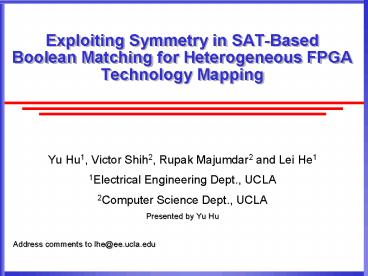Exploiting Symmetry in SATBased Boolean Matching for Heterogeneous FPGA Technology Mapping - PowerPoint PPT Presentation
Title:
Exploiting Symmetry in SATBased Boolean Matching for Heterogeneous FPGA Technology Mapping
Description:
Exploiting Symmetry in SAT-Based. Boolean Matching for Heterogeneous FPGA ... The solution of this SAT problem corresponds to the Boolean matching results ... – PowerPoint PPT presentation
Number of Views:65
Avg rating:3.0/5.0
Title: Exploiting Symmetry in SATBased Boolean Matching for Heterogeneous FPGA Technology Mapping
1
Exploiting Symmetry in SAT-Based Boolean
Matching for Heterogeneous FPGA Technology Mapping
- Yu Hu1, Victor Shih2, Rupak Majumdar2 and Lei He1
- 1Electrical Engineering Dept., UCLA
- 2Computer Science Dept., UCLA
- Presented by Yu Hu
- Address comments to lhe_at_ee.ucla.edu
2
Outline
- Background and Motivations
- Review of Standard SAT-based Boolean Matching
- Proposed Improvements
- Experimental Results
- Conclusion and Future Work
3
Background
- FPGA technology mapping
- Map a design into a network of Programmable
Logic Blocks (PLBs) - Optimize for area, speed and/or power
- PLB containing heterogeneous devices requires
Boolean matching (BM) to determine whether
function fcan be implemented by hardware
component H
4
Example Boolean Matching (BM) for PLB
- Answer a Yes-No question
- Can a Boolean function f be implemented in PLB p?
- If yes, give the configuration bits of LUTs.
f1 (e c d b)a i.e., f1 za z e c
d b
f1 ea ca da ba f2 a b c d e
5
Motivation for SAT Based PLB BM
- Application of FPGA PLB Boolean matching
- Technology mapping
- Re-synthesis
- Existing BM algorithms
- Decomposition based BM is lack of flexibility,
i.e., algorithm is only applicable to selected
BLE structure Cong, TCAD01 - BDD based BM is not scalable (memory explosion)
Ciric, TCAD03 - Fast BM is hard to deal with programmable devices
Wei, ISQED06 - SAT based BM Ling, DAC05Safarpour,
DAC06Cong, FPGA07 - Introduces extreme flexibility
- Provide a tradeoff between memory and runtime to
deal with complicated BLE structures - Still slow, hard to be applied to complex PLBs
6
Review SAT Based Encoding for BM
- Encoding non-programmable devices
- Requires common/interconnect variables
- Is a linear time procedure
- Example
f AND (x2z1) (x1z1) (x2x1 z1)
f OR (x3g) (z1g) (x3z1 g)
f total fAND fOR (x2z1) (x1z1) (x2x1
z1) (x3g) (z1g) (x3z1 g)
7
Review SAT Based Encoding for BM
- Encoding programmable devices
- Configuration bits are encoded
f LUT ( x1 x2 L0 z1) ( x1 x2
L0 z1) ( x1 x2 L1 z1) ( x1
x2 L1 z1) ( x1 x2 L2 z1) ( x1
x2 L2 z1) ( x1 x2 L3 z1) ( x1
x2 L3 z1)
8
Review SAT Based Encoding for BM
Configuration bits are encoded as SAT literals
G AND2 ( x3 f ) ( x3 f ) ( x3 z f )
G LUT2 ( x1 x2 L0 z) ( x1 x2
L0 z) ( x1 x2 L1 z) ( x1
x2 L1 z) ( x1 x2 L2 z) ( x1
x2 L2 z) ( x1 x2 L3 z) ( x1
x2 L3 z)
The solution of this SAT problem corresponds to
the Boolean matching results
G G AND2 G LUT2
SAT G expand GX/000, f/0 , z/z0 GX/001,
f/0, z/z1 GX/010, f/1 , z/z2 GX/011,
f/0 , z/z3 GX/100, f/1 , z/z4 GX/101,
f/1 , z/z5 GX/110, f/1 , z/z6 GX/111,
f/1 , z/z7
Boolean function
9
Handle Input Permutation and Bridge
Virtual MUXes increase runtime exponentially!
10
Impact of Virtual MUXes
11
Symmetries in Circuits and PLB
- Functional Symmetries
- Variable a and variable b are symmetric if
swapping a and b does not change the truth table
of function F(,a,,b,) - General symmetries which consider the permutation
of more than two variables can also be explored - Eg F(a,b,c) a(bc), where b and c are
symmetric - Architectural Symmetries
- Structures of certain inputs of a PLB are
equivalent - Eg Inputs of the primary input LUTs of each PLB
are symmetric - F(a, b, c, d)
F(b, a, c, d)
12
Impact of Considering Symmetries
- The number of distinct permutations under
symmetries decreases substantially - Functional symmetries and architecture symmetries
independently reduce 100x permutations
13
Overall Algorithm
Boolean function
Target architecture
Functional symmetry detection
Pre-calculate architecture symmetries patterns
Pruning by architecture symmetries
Architecture symmetry information
Non-redundant permutation set (NPS)
Generate characteristic function template
Is NPs empty?
Characteristic function template
Y
N
Pop a permutation p
Exit
Pre-process for the target PLB, one-time cost
14
Overall Algorithm (cont.)
Is NPs empty?
Target architecture
Y
N
Pre-calculate architecture symmetries patterns
Pop a permutation p
Architecture symmetry information
Replicate CNFs of p
Solve the SAT problem
Generate characteristic function template
N
SAT?
Characteristic function template
Y
Return implementable
Exit
Pre-process for the target PLB, one-time cost
15
Experimental Results
- Experimental settings
- Tested by Boolean functions in MCNC circuits
- Target PLB is PLB_d
- Use minSAT1.14 to solve SAT instances
- Obtain over 100x speedup compared to the standard
approach Ling05
Breakdown of speedup techniques
16
Conclusions and Future Work
- An improvement for SAT-based Boolean matching is
presented by considering functional and
architectural symmetries - Over 100x speedup is obtained compared to the
standard SAT-based Boolean matching approach - Future Work
- Integrate the improved SAT-based Boolean matcher
into heterogeneous FPGA technology mapping phase - Perform architecture exploration by our improved
technology mapper
17
Thank You!
- Exploiting Symmetry in SAT-Based Boolean
Matching for Heterogeneous FPGA Technology
Mapping - Yu Hu, Victor Shih, Rupak Majumdar and Lei He

